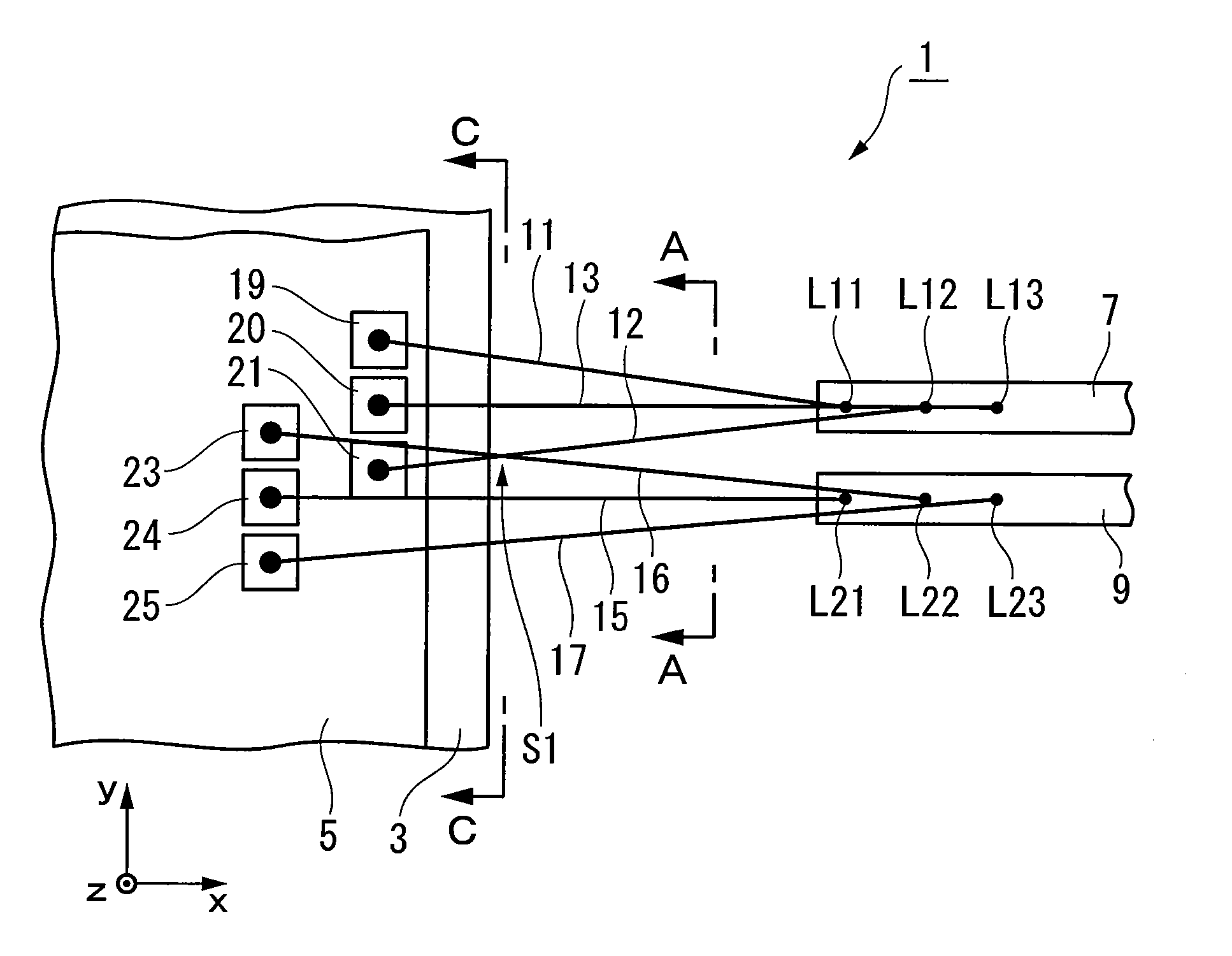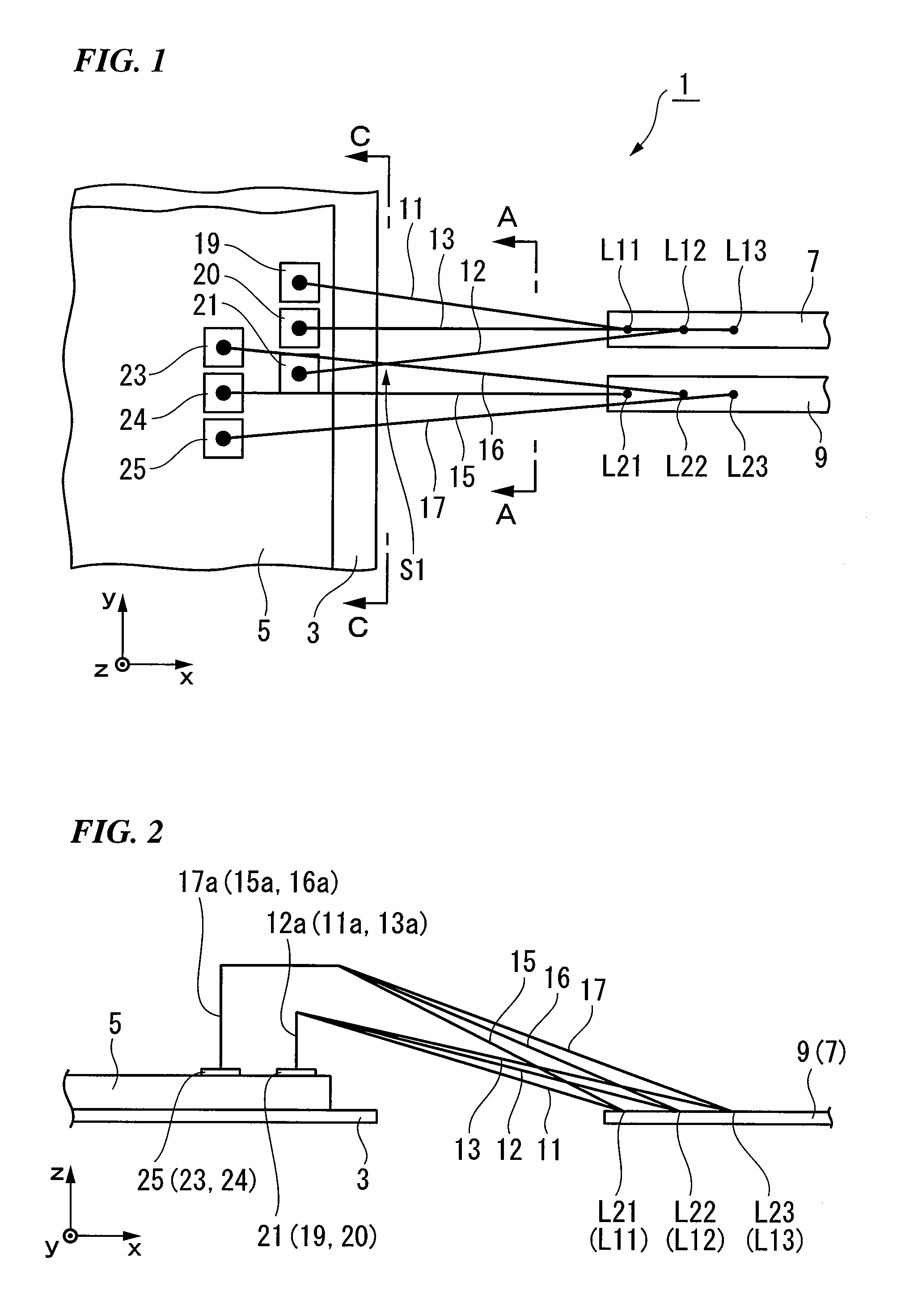Semiconductor device and wire bonding method therefor
a technology of semiconductor devices and wire bonding methods, which is applied in the direction of semiconductor devices, semiconductor/solid-state device details, electrical apparatus, etc., can solve the problems of unexpected voids, wire heating and melting, and electric short-circuiting between wires
- Summary
- Abstract
- Description
- Claims
- Application Information
AI Technical Summary
Benefits of technology
Problems solved by technology
Method used
Image
Examples
first embodiment
1. First Embodiment
[0070] A semiconductor device 1 according to a first embodiment of the present invention will be described with reference to FIGS. 1 to 4. As shown in FIGS. 1 and 2, a plurality of leads 7 and 9, which are positioned adjacent to each other, are arranged in the periphery of a semiconductor chip 5 mounted on a stage 3 having a planar shape, wherein the lead 7 is electrically connected to three electrode pads 19 to 21 via three wires 11 to 13, and the lead 9 is electrically connected to three electrode pads 23 to 25 via three wires 15 to 17. Plural sets of the lead and three electrodes connected via three wires are arranged for the semiconductor chip 5.
[0071] Each of the leads 7 and 9 has a slender shape elongated toward the semiconductor chip 5. Second bonds L11 to L13 connected to the wires 11 to 13 are aligned in the lead 7 in its longitudinal direction, and second bonds L21 to L23 connected to the wires 15 to 17 are aligned in the lead 9 in its longitudinal dire...
second embodiment
2. Second Embodiment
[0103] Next, a wire bonding method according to a second embodiment of the present invention will be described with reference to FIGS. 7A to 7C, FIGS. 8A and 8B, FIGS. 9A to 9C, FIGS. 10A and 10B, and FIGS. 11A and 11B. As shown in FIGS. 7A-7C, 8A, 8B, 9A, and 9B, the wire bonding method is performed to establish electrical connection between bonding pads 101a formed on a semiconductor chip 101 mounted on a board 103 and electrode pads (or connection pads) 103a formed on the board 103 in the periphery of the semiconductor chip 101 via metal wires 105.
[0104] As shown in FIG. 7A, the semiconductor chip 101 is mounted on the board 103 in advance so that the electrode pads 103a are formed on the board 103 in the periphery of the semiconductor chip 101. Herein, a small-diameter capillary 109 is used to supply thin wires 107 whose diameters are smaller than diameters of the metal wires 105. The terminal end of the small-diameter capillary 109 is pressed onto the elect...
third embodiment
3. Third Embodiment
[0131] A semiconductor device 201 according to a third embodiment of the present invention will be described with reference to FIGS. 12 to 14. As shown in FIGS. 12 and 13, a semiconductor chip 205 is mounted on a surface 203a of a stage 203 having a planar shape in plan view, wherein a plurality of electrode pads 207 and 209 are formed on a surface 205a of the semiconductor chip 205. A plurality of leads 211 and 213 are arranged in the periphery of the semiconductor chip 205, wherein they are connected to the electrode pads 207 and 209 via a plurality of wires 215 and 217.
[0132] In the semiconductor chip 201, the stage 203, the semiconductor chip 205, and the wires 2215 and 217 are sealed with a molded resin 219, which also integrally fixes the stage 203, the semiconductor chip 205, the leads 211 and 213, and the wires 215 and 217 in prescribed positioning.
[0133] The electrode pads 207 and 209 are alternately aligned in different lines on the surface 205a of the...
PUM
 Login to View More
Login to View More Abstract
Description
Claims
Application Information
 Login to View More
Login to View More - R&D
- Intellectual Property
- Life Sciences
- Materials
- Tech Scout
- Unparalleled Data Quality
- Higher Quality Content
- 60% Fewer Hallucinations
Browse by: Latest US Patents, China's latest patents, Technical Efficacy Thesaurus, Application Domain, Technology Topic, Popular Technical Reports.
© 2025 PatSnap. All rights reserved.Legal|Privacy policy|Modern Slavery Act Transparency Statement|Sitemap|About US| Contact US: help@patsnap.com



